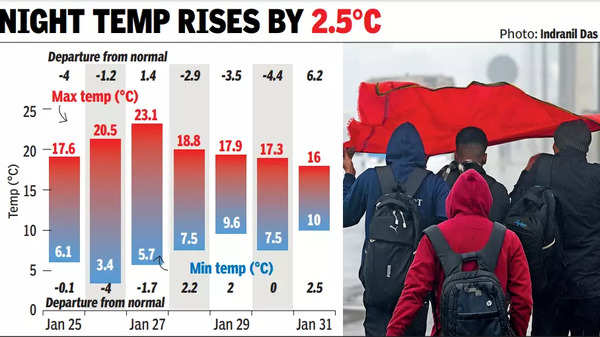
The maximum temperature fell by a notch from Tuesday’s 17.3 degrees Celsius to 16 degrees C on Wednesday. It was over 6 degrees C below normal, making Wednesday the season’s sixth ‘cold day’.Wind speed dipped by 1kmph — it was 11kmph, from 12kmph a day before — bringing chill from the snow-clad mountains.
The night temperature, however, rose by 2.5 degrees C from the previous day to 10 degrees C. It was 2.5 degrees above normal.
India Meteorological Department (IMD) classifies a day as ‘cold’ when the maximum temperature drops 4.5 notches below normal, with the minimum also dipping to single digits, while a ‘severe cold’ day is when the maximum temperature drops below normal by 6.5 degrees Celsius or more. A ‘cold wave’ is declared when the minimum temperature of the station is less than 4 degrees Celsius.
The city has recorded seven ‘cold days’, six ‘severe cold days’ and three days of cold wave so far this season.
Wednesday saw dense fog throughout, with drizzle around 1.30pm in some parts of the city doing little to dissipate it. At 3.40pm, light showers were witnessed.
Low visibility due to the dense fog was reported in Rajiv Chowk, Udyog Vihar and Golf Course Road Extension. Commuters caught off guard by the rain were seen taking shelter beneath underpasses. “It was a very gloomy day as there was no sun. I was feeling extremely cold, and going out for groceries in the evening was tough,” said Aditi Das, a resident of South City 1.
IMD’s forecast of rain and thunderstorms in the city on Feb 1 and Feb 3 due to a western disturbance remained unchanged. It has issued a ‘yellow alert’ (be aware) for these two days.
“A fresh western disturbance is likely to affect the region from Feb 3. Very light rain occurred at isolated places in Haryana. Dense to very dense fog was reported in a few places,” said an IMD official.
Health experts urged residents to wear masks and several layers of warm clothes while stepping out, which will help reduce stress on the respiratory system. While personal preventative measures are important, addressing the underlying causes of pollution and pushing for environmental sustainability are critical for long-term solutions, they said.
Dr Ashutosh Shukla, senior director (internal medicine), Max Hospital, said: “The prevalence of viral flu-like illnesses has significantly gone up, primarily because of extreme cold weather and poor air quality for a prolonged period. The viruses causing flu tend to propagate more easily in such conditions. People with poor immunity and chronic diseases like diabetes, lung diseases or pre-existing heart conditions, especially senior citizens, are highly likely to be affected by flu. Compared to last year, the percentage of patients with cold and flu in the OPD has gone up by around 30%.”
The capital also witnessed rain on Wednesday, leading to a dip in daytime temperature. Some areas saw “cold day” or “severe cold day” conditions.
India Meteorological Department has sounded a “yellow” alert for moderate to dense fog on Thursday and Friday. Very light rain is expected on Thursday.
The Met department’s data shows that the maximum temperature was 18.6 degrees Celsius, four degrees below normal, at Safdarjung, which is the city’s base station.
“Severe cold day” conditions were seen on the Ridge as the maximum temperature dipped to 16.2 degrees Celsius, 6.6 degrees below normal. “Cold day” conditions were recorded at Palam and Ayanagar where the maximum temperature dropped to 17 and 17.4 degrees Celsius, respectively. At 13.9 degrees Celsius, Jafarpur recorded the lowest maximum temperature. The minimum temperature at Safdarjung was recorded at 7.3 degrees Celsius, one degree below normal.
Delhi got light showers on Wednesday afternoon and another spell of rain with strong winds on Wednesday night. From 8.30am to 5.30pm, Safdarjung logged 8.5mm of rainfall.